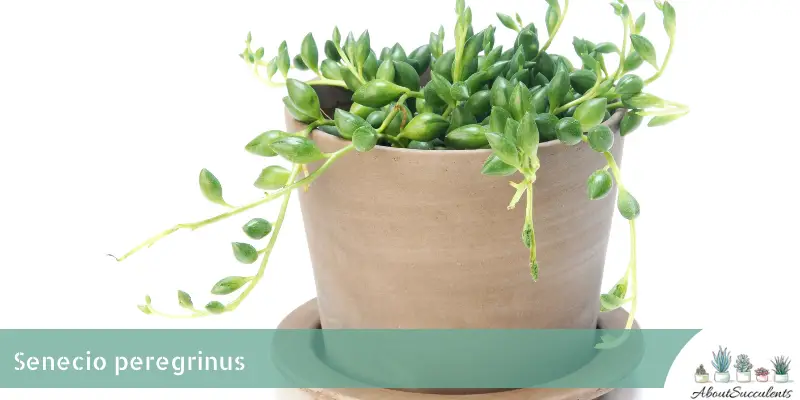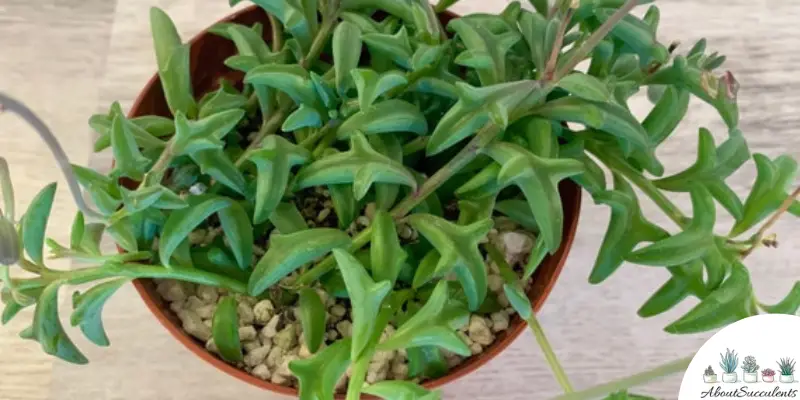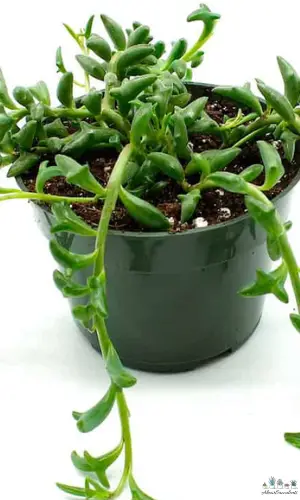
Senecio peregrinus is a succulent that’s truly delightful to look at with its trailing thin stems that feature green-colored, oddly-curved, dolphin-shaped leaves. For this reason, this rare succulent goes by nicknames that allude to its peculiar shape – “String of Dolphins”, “Dolphin Necklace”, “Flying Dolphins”, and “Dolphin Plant”.
As cute and charming as the leaves look, the shape appears to serve a special function for Senecio peregrinus in that it helps the plant absorb more sunlight.
String of Dolphins is a hybrid of Curio Rowleyanus (“String of Pearls”) and Curio Articulatus (“Candle Plant”), both of which belong to the Senecio genus. The succulent’s origin has been traced to Southwest Africa and is a member of the Asteraceae family.
As Senecio peregrinus matures, it starts to spread outward. Landscapers can use Dolphin Plant as ground cover or as a trailing plant in a hanging basket. Within a year, the slender stems can grow to a length of 36-inches (91cm).
Flying Dolphins will produce delicately small, white-colored, and puffball-shaped flowers that appear with golden yellow or bright-red filaments during the Fall months. The flowers emit a pleasant scent that’s similar to cinnamon spice.
General Information:
Also known as: String of Dolphins, Dolphin Necklace, Flying Dolphins, and Dolphin Plant.
Plant Family: Asteraceae
Origin: Hybrid of Curio Rowleyanus and Curio Articulatus; native of Southwest Africa
Height: 36-inches (91cm)
Exposure: Preferably up to 6 hours exposure to partial sun but direct sunlight is also good as long as it’s not the afternoon sun
Water Needs: Drought-tolerant; use the “Soak and Dry” method for watering
Soil Type: Cactus mix or succulent soil will be fine. Another option is 2 parts potting soil mixed with 1 part 50% perlite, pumice, coarse sand, and lava rock to speed up soil drainage.
Soil pH: 6.6 to 7.5
How to Grow and Care for Senecio Peregrinus

Senecio peregrinus is easy to grow and care for. Just remember that its needs for sunlight and water are as different as night and day.
Sunlight every day and water only sparingly – whenever the soil has completely dried out. Keep this rule in mind and your String of Dolphins will come along swimmingly.
Dolphin Plant will thrive better in the great outdoors because of the abundance of sunlight and the quality of the soil. But with just a bit more effort, you can successfully grow Dolphin Plant indoors.
In fact, it would be better to grow Senecio peregrinus indoors if the temperature in your region falls below 30° F (-1.1° C) because this isn’t a cold-hardy succulent.
Plant hobbyists usually grow Dolphin Necklace as a hanging succulent indoors to adorn bookshelves and stairwells.
Good outdoor ideas for Senecio peregrinus would be to include it as part of a vertical garden or have an experienced landscape gardener train the Flying Dolphins to climb a trellis or a moss pole.
There are a lot of possibilities with Senecio peregrinus as long as you grow and care for it properly.
Sunlight
Senecio peregrinus needs sunlight but not as much as other types of succulents. They do well under full sunlight but to be on the safe side, if you’re planting Dolphin Plant with other succulents in an outdoor area, put it in an area where it can get up to 6 hours of partial sunlight.
For sure, you must protect String of Dolphins from the intense rays of the afternoon sun because its leaves will burn. To make Senecio peregrinus happy, the morning sun will always be the better and healthier choice.
As a houseplant, place Flying Dolphins near a south-facing window where the succulent plant can get 6 hours of morning sunlight. Another option would be to place the succulents under an LED Grow Light for the required number of hours. This would be an ideal solution during the winter months.
Watering
Giving Senecio peregrinus water while the soil still has moisture is bad for the plant’s health. If the roots are kept in a moist environment for a long time, they will rot and expose the plant to a high risk of contamination.
Unlike sunlight which String of Dolphins needs to have every day, you only water its soil between dry periods.
During the summer and spring months, you might decide to water only every seven to 10 days. To be sure, always check the soil’s level of dryness. Simply insert a stick an inch deep into the soil and if the end feels dry after you pull it out, give the soil a good soaking.
This is called the “Soak and Dry” method where you water the soil only between dry periods.
When winter rolls in, expect to water the soil much more sparingly – maybe only once a month.
Pot and Soil

As mentioned before, Senecio peregrinus can be displayed as a hanging succulent. Choose a container that’s made of either unglazed ceramic or terracotta because these types of materials are highly absorbent of moisture and will help dry out the soil faster.
The size of the pot must be slightly larger than the base of the plant to maintain proper soil aeration and to allow the roots to grow without getting tangled up. Lastly, the pot must have a drain hole at the bottom to filter out excess water.
String of Dolphins thrives in arid, well-draining soil such as cactus or one that’s specifically formulated for succulents. You can also combine 2 parts of potting soil with 1 part of pumice, perlite, and coarse sand.
Fertilizer is not important if you’re growing Senecio peregrinus outdoors. But if the Flying Dolphin is kept indoors, adding organic fertilizer to the soil will give the plant more nutrition.
You can also use organic compost, manure, peat moss, or vermicompost. Other options for soil nutrition are liquid plant food and slow-release fertilizers.
Use fertilizer only during the growing season. At most, fertilize only once a month and dilute the formula to a quarter of its original strength. Too much fertilizer will kill the leaves.
If Senecio peregrinus is growing too big for its current pot, it must be transferred to a new one. You must repot only during the summer or spring. Transfer to a pot that’s 1.5-times bigger than its old pot and use a fresh batch of succulent soil.
How to Propagate Senecio Peregrinus
Thinking of having more Strings of Dolphins in the garden, at home, or perhaps as gifts to friends and family? The good news is that you can propagate Senecio peregrinus via leaves.
Leaves Method
Step 1: Choose a healthy leaf that’s growing near the stem of the main plant and perform a clean twist and pull. Make sure no part of Flying Dolphin is left on the stem or propagation won’t be successful. If this does happen, repeat the process.
Step 2: Let the leaves form calluses over a period of 2 to 4 days.
Step 3: Place the leaves on top of well-draining soil. The leaves must have ample distance from each other.
Step 4: Lightly water the soil and move the container near an area that gets up to 6 hours of partial sunlight every day. You can also use a Grow Light.
Step 5: Observe the leaves. If the roots have sprouted and taken hold of the soil, water only when the soil has gone dry.
Frequently Asked Questions
Is Senecio Peregrinus Toxic to Cats and Dogs?
Yes, Senecio Peregrinus is a hybrid of Curio Rowleyanus which appears on the list of plants that are toxic to cats and dogs found on the website of the American Society for the Prevention of Cruelty to Animals (ASPCA).
Why is my Senecio Peregrinus Dying?
Senecio peregrinus is a no-frills succulent to grow but as we advised earlier, you have to keep a tight watch on its watering schedule. Also, look out for spider mites, aphids, and mealybugs as these pests will eat the leaves of String of Dolphins and drain them of sap.
Overwatering
Discoloration and/or the look of mushiness on the leaves are symptoms of an infection taking place inside Senecio peregrinus because its roots are rotting.
You must act right away and cut off the infected sections with a sterilized knife to localize the contamination. After you’ve disinfected the knife with 70% isopropyl alcohol, remove the plant from its soil and cut off the roots that have rotted away.
Begin the process of repotting by filling up a new pot with fresh cactus or succulent soil. Repot Dolphin Plant after 1 to 2 days but don’t water it for 2 to 3 days more to give the succulent enough time to get used to its new environment.
Pest Infestation
Pests leave white, waxy substances on the plant’s leaves which could become a full-blown fungal infection. Remove these substances with a mild fungicide or wipe them off with a cotton ball soaked in 70% isopropyl alcohol.
To keep pests away from Senecio peregrinus, spray it with a natural insecticide such as neem oil. Make sure to dilute the insecticide before spraying.
Yes. Senecio peregrinus produces small, delicate-looking, puffball-shaped, white-colored flowers that have golden yellow or bright-red filaments in the Fall season. The flowers emit a mild cinnamon-like fragrance.
Last Updated on June 14, 2022 by Sofia Lara